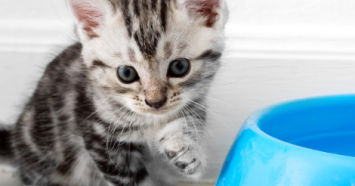
What foods and how much to feed a kitten can be pretty confusing. Some kittens seem to be hungry all the time, yet they eat seemingly small amounts. How do you know if you are feeding your kitten enough or giving them proper nutrition?
What to Feed Kittens
Kittens need either their mothers’ milk, formula (milk replacer), or kitten food. Treats are okay but should not be a large portion of their diet. Table scraps, cow’s milk, and homemade diets should be avoided. The major reason behind this are that growing kittens have special dietary needs, especially compared to adults. They need a key set of nutrients and plenty of appropriate calories, all balanced carefully to meet the needs of their growing bodies.
Not all foods are created equal. Some have soft kibbles to make chewing easier, others have crunchy kibbles; some wet foods have a stew consistency, whereas others are all one texture. Cats tend to develop a preference for certain textures, so options are important. Premade foods may have different serving sizes and calorie contents.
How much should a kitten eat?
Feeding kitten food (or formula) is a nice option because it comes with instructions. Most kitten food bags and cans have suggested feeding guides on the label. It may be in chart form or written as a list. Most provide feeding guidelines based on the age range and weight range of the kitten. This is a super easy and convenient way to ensure you are not over- or under-feeding your kitty.
Milk/Formula vs. Kitten Food
If the kitten is younger than 3 weeks old (i.e. before baby teeth come in), he or she typically only needs milk or formula. Once teeth start coming in, the mom will begin weaning kittens off her milk so they can transition to solid food. If you are feeding formula, you can do this by mixing kitten food with either their formula or water so that it is very dilute and mushy. Canned or dry food is fine as long as the end result is very soft. After 1-2 weeks, you can transition totally to kitten food, but make sure there is plenty of water available to drink at all times.
How Often to Feed a Kitten: Free Feeding vs. Set Feeding Schedule
While there is no set schedule for when to feed a kitten, you may notice that he or she seems to become hungry at specific times throughout the day. When kittens are very small, it may be best to break up their calories into numerous small meals throughout the day (5-6) or even leave the food out all the time. Leaving out canned food, milk, or softened food isn’t ideal because bacteria or mold may grow in the food, but leaving out dry food is okay.
Drinking Less Water on Wet Food
If you decide at some point to switch your kitten from dry food to wet or canned food, he or she may drink less water than usual. This is because wet/canned food has a higher water content, so the kitten may not be as thirsty. He or she will still need access to water at all times.
Always Change Diet Slowly
Try to avoid abruptly changing the kitten’s diet from one food to another. It can cause an upset stomach in many pets. To switch foods, mix the old food and new foods together for at least several days before transitioning over to the new food completely.
When in Doubt, Ask the Vet
Kittens should get regular checkups (e.g. every 2-3 weeks during the vaccine or shot series) as they are growing. Your veterinarian will monitor your kitty’s weight and overall appearance at each visit. While the vet will likely talk to you about how to kitten is developing, be sure to discuss any concerns you have about feeding too much or too little. Be prepared to answer how often you feed your kitten, what he or she is eating, how hungry he or she seems, and how much playtime he or she gets. Bowel movements and drinking/urination habits may also be helpful to know.